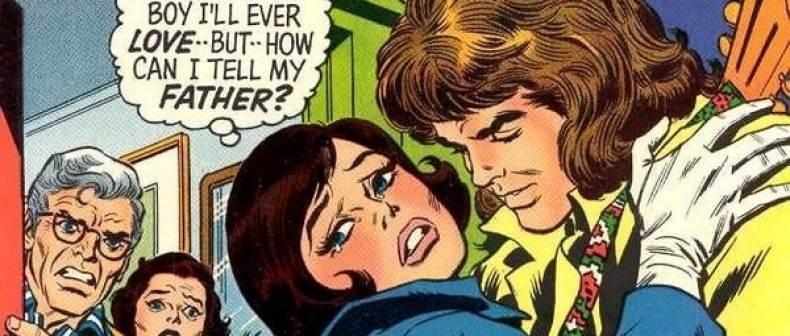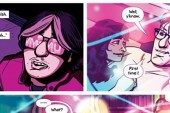
The only reason teenage girls listen to rock music, allegedly (cover by John Romita)
There’s an interview on heavy metal news site Lambgoat, conducted by site owner Alex Arnold, with guitarist Jake Harmond of Chelsea Grin. I’ve addressed this interview previously, but I’m going to do so once again because it so perfectly, dreadfully illustrates a fundamental flaw in the relationship between many heavy metal bands, the media and metal fans – specifically, metal fans who are also teen girls. In the interview, Arnold and Harmond both refer to young women who like Chelsea Grin and make a concerted effort to see their live show, often attending multiple shows in a single tour cycle, as “groupies,” directly or indirectly.
“Arnold: Does a band like Chelsea Grin have groupies? Clue me in. Will there be 17-year-old girls following you around after your Warped Tour sets?”
“Harmond: Our fan base seems to be 14-19 years old mostly, so there is definitely an abundance of young girls that tend to follow us around.”
14-to-19-year-old young women, fans of the band because they love the music, are positioned as though they are specifically there for the sexual fulfillment of the group’s members. It is exchanges like this – and there are many – that illustrate a particular flaw in the interaction between heavy metal bands and a specific portion of their audience: heavy music is deeply uncomfortable with the affection of teenage girls.
There is no love more problematic, more reviled in the heavy metal community than that of a teenage girl. For a band to be referred to as “girlfriend metal” is usually an insult, indicating that the content is too emotional or the instrumentation too soft for the tougher, more discerning listener. Saying a fellow fan listens to “girl metal” is a way to attack someone’s tastes. Live reviews often point out that the audience is full of teen girls as a way to give credence to a claim that an act’s music is overly produced or pop-influenced.
The other side of this coin is, of course, that it positions the fan who is imagined as the opposite of the teen girl – the adult male – as the true arbiter of taste in aggressive music. If men approve of an album, if they think it’s brutal enough or sophisticated enough, then that opinion has value and weight. In turn, groups go out of their way to cater to, and impress, their male fans, to curry favour and attract their attention. On the other hand, because the love of female teen fans is seen as something reductive and dangerous, bands respond by regarding this contingent of their audience with suspicion.
I’m speaking in broad-stroke generalizations, of course. When I was at an Amon Amarth show at the Opera House a couple of years ago, singer Johann Hegg asked for all the women in the audience to let out a Viking shout. After they died down, he sighed happily and said: “That was beautiful.” But for every moment like that there’s another like the show where Suicide Silence frontman Mitch Lucker threatened to knock the teeth out of a young woman in the front row.
* * *
There’s a passage in Mary Borsellino’s book, The Devil’s Mixtape, where a character rants about the lack of love creators have for their teen girl fans that knocks the wind out of my lungs every time: “As soon as teenage girls start to profess love for something, everyone else becomes totally dismissive of it. Teenage girls are open season for the cruellest bullying that our society can dream up. Everyone’s vicious to them. They’re vicious to each other. Hell, they’re even vicious to themselves. It’s terrible.
“So, if teenage girls have something that they love, isn’t that a good thing? Isn’t it better for them to find some words they believe in? Isn’t it better for them to put those words on their arm in a tattoo than for them to cut gashes in that same skin? Shouldn’t we be grateful when teenage girls love our work? Shouldn’t that be a fucking honor?
“It’s used as the cheapest, easiest test of crap, isn’t it? If teenage girls love a movie, a book, a band, then it’s immediately classified as mediocre shit.”
The irony of the lack of respect teen girls receive back from the objects of their affections is that the young female demographic has been proven again and again to be a notoriously difficult target audience to crack. Marketers and branding specialists consider teen girls an extremely difficult group to impress. And even if a product or piece of art succeeds in capturing their attention, retaining it is an even greater challenge.
In the article linked to above, writer Clare O’Connor explains (in a callous and reductive manner, admittedly) that the key to capturing teen girls’ attention “is to understand that teenage girls are just as concerned with their own insecurities as they are with celebrity gossip, fashion and beauty.” Or, more accurately and generously, that teen girls have rich inner lives and feel deeply. They are looking for ways to navigate a difficult world and cling to the work that means something to them, that helps them define and defend themselves. Because their day-to-day lives are incredibly intense, their attention is difficult to attract, but the things that reach them matter profoundly.
It’s not simply all the evidence suggesting that teen girls represent a tricky and discerning market, but that teenage girls love the things they become fans of with a burning and transformative energy. The things that they love become a part of their core identity. They define themselves by the art that they like, the fandoms they ascribe to and the media they consume. In the latest edition of her Vice column “Girl News,” Kate Carraway touches upon this with language that fluctuates between the obtuse and lovely: “Teenage girls as nerds. They’re the most nerds. Listening to teenage girls talk about something they like is so, so, so much worse than listening to guys who are into gaming or whatever, because at least those dudes have been made comfortable with sexual and social rejection, and know enough to incorporate some shame into their enjoyment. Teenage girls have no kind of barrier between themselves and what is rad.”
Teenage girls love what they love shamelessly and passionately. They will wear the same band shirt every day. They will go to every live show that you play and buy all of your merch. They will play their music for their friends. They will write about you on message boards and online. They will stand in the front row and throw themselves at the barrier and scream.
Who wouldn’t want their band to be loved by teenage girls?
* * *
I’ve been thinking about audience lately. Specifically, how people who create things build, serve and curate their audiences. I just wrote a Tumblr post about it, how the art that we make is directly related to the audience that we choose – and the potential audience we alienate. When we make belittling, humiliating or sexist art we wound and betray a potential audience and appeal to another.
I believe the reason why the topic of “women in metal” keeps coming up over and over again is that labels and magazines, bands and promoters are finally, finally starting to get an inkling that there is a huge audience out there. They have discovered that there is an audience of young women who desperately want an access point to this difficult and aggressive genre of music, just waiting for an invitation. We can see a glimmer of understanding that there is a huge secret army of young female metalheads in the making. There are women who already love the music, but have been shamed out of expressing it, and young women who haven’t yet found the thing that might actually be a life-saving type of art.
However, while the affection of young women is sneered at and regarded as less valuable than the attention of male fans, any change will remain a possibility rather than a reality. But for every article on women in metal, each gesture towards valuing the contributions and affection of female fans, this invaluable change moves a little closer. For every male listener whose whims have been catered to declaring that he’s bored with all this attention being paid to women in metal, there’s a young woman who’ll be thrilled that someone is finally speaking to her, letting her in, who wants her to be their fan, reader or listener, who thinks her love is valuable.
____
Natalie Zina Walschots is a poet and music writer based in Toronto, Ontario. Her second book of poetry, DOOM: Love Poems for Supervillains, was published by Insomniac Press this spring. You can follow her on Twitter at @NatalieZed.
For more, follow us on Twitter at @torontostandard, and subscribe to our newsletter.














